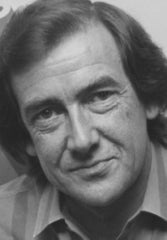Donald Banks
 Donald Oscar Banks (1923-1980), composer, was born on 25 October 1923 in South Melbourne, son of Donald Waldemar Banks, musician, and his wife Elsie Catherine Sophia, née Carlson, both Victorian born. Educated at Cambridge College, Albert Park, during the Depression young Don transferred to Middle Park Central School and next to Melbourne Boys' High School. He had begun piano lessons at the age of 5 and learned to play the saxophone, violin and trombone in his youth. From an early age he 'sat in' on his father's dance band, and later played trombone with other bands, including that of Graeme Bell.
Donald Oscar Banks (1923-1980), composer, was born on 25 October 1923 in South Melbourne, son of Donald Waldemar Banks, musician, and his wife Elsie Catherine Sophia, née Carlson, both Victorian born. Educated at Cambridge College, Albert Park, during the Depression young Don transferred to Middle Park Central School and next to Melbourne Boys' High School. He had begun piano lessons at the age of 5 and learned to play the saxophone, violin and trombone in his youth. From an early age he 'sat in' on his father's dance band, and later played trombone with other bands, including that of Graeme Bell.
On leaving school, Banks was employed as an office-boy for a solicitors' firm and then for a hardware company. In 1941-46 he served in the Australian Military Forces, mainly with the Australian Army Medical Corps in Melbourne. Small and wiry (8 st. 7 lb., 54 kg), he was judged unfit for tropical service. Through the postwar Army Rehabilitation Scheme, he undertook a diploma course at the University Conservatorium of Music in 1947-49: he studied composition with A. E. H. Nickson and Dorian Le Gallienne, and graduated with first-class honours. Banks performed publicly his Sonatina for Piano before departing for England in 1950.
In London he studied with Matyas Seiber, won the Edwin Evans memorial prize for composition in 1952, and supported himself by taking jobs as a copyist and as a member of a dance band. After working briefly with Professor Milton Babbitt at Salzburg, Austria, in 1953 Banks won an Italian government scholarship to study with Luigi Dallapiccola at Florence, Italy.
On 5 August 1953 at the register office, Paddington, London, Banks married Valerie Frances Miller, a children's welfare officer. His compositions began to win recognition: that year his Four Pieces for Orchestra was performed by the British Broadcasting Corporation, and Schott & Co. commenced publishing his works. In 1954 he won the City of Haifa (Israel) prize for chamber music. Commissions followed from the B.B.C., the Edinburgh, Bromsgrove and Farnham festivals, the Peter Stuyvesant Foundation, the University College, Cardiff, and the English Bach Festival. He won the Sir Arnold Bax Society medal in 1959. A fellow Australian, Barry Tuckwell, gave the first performance of Banks's Concerto for Horn and Orchestra with the London Symphony Orchestra in 1966. To support his family, Banks also worked commercially, notably as a composer of scores for Hammer horror films.
His creativity was characterized by the emphasis he gave to the craft and professionalism of being a composer. Banks's personality and training attracted him to serial theory and techniques. He co-operated in developing an early synthesizer, the VCS1, and became interested in electronics as a possible source for new sounds; in a number of works he strove to combine conventional acoustic instruments with new synthetic ones, as in his Commentary for piano and tape.
Jazz continued to influence his work. He sought to bring together jazz and art musicians in works such as Equations I, II and III (1963, 1969, 1972), Settings from Roget (1966) which he wrote for Cleo Laine, Meeting Place (1970) for jazz ensemble, chamber group and electronics, Synchronos '72 for jazz ensemble, various instruments, electronics and visual displays, Take 8 (1973) for jazz ensemble and string quartet, and Nexus (1971), one of his best-known works, for jazz ensemble and symphony orchestra.
Proud of his Australian identity, in the early 1950s Banks had founded—with Margaret Sutherland—the Australian Musical Association as 'a platform for Australian performers and to get exposure for Australian composers'. He was also chairman (1967-68) of the Society for the Promotion of New Music, a foundation member of the British Society for Electronic Music and patron of the Jazz Centre Society, London. In 1969-71 he was musical director at Goldsmith College, University of London.
Having attended the Perth Festival in 1970, Banks returned permanently to Australia in 1972 when he took up a creative arts fellowship at the Australian National University, Canberra. Next year he was appointed head of composition studies at the Canberra School of Music where he founded an electronic music studio. He was chairman (1973-74) of the music board of the Australian Council for the Arts and an executive-member of the Composers' Guild of Australia. From 1978 he was head of composition at the New South Wales State Conservatorium of Music.
Small and frail-looking, with glowing eyes, Banks was animated in movement and gesture. He valued 'mateship' and battled to secure composers' rights. His vision for music in Australia included a high level of professionalism for Australian composers, a steering away from self-conscious nationalism and an absorption of world music which he hoped would lead to the emergence of an Australian 'sound'. In 1980 he was appointed A.M. After suffering for eight years from chronic lymphocytic leukaemia, he died of cancer on 5 September 1980 in his home at McMahons Point, Sydney, and was cremated. His wife, two daughters and son survived him.
(Larry Sitsky - Australian Biography Dictionary)
